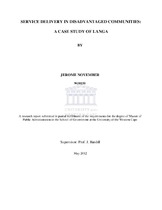| dc.description.abstract | In order to address the inequalities created by the apartheid regime between local authorities, various legislative and support mechanisms were put in place which were not always implemented effectively and efficiently. For this reason, the amalgamation of the previous racially based local authorities from 843 to 283 was introduced in terms of the Local Government Transition Act (LGTA) of 1995 and in particular the Local Government Municipal Demarcation Act of 1998. This reduction in the number of municipalities may have reduced the level of administration disruption but gave rise to institutions still being plagued by inequitable service delivery which impacted negatively on disadvantaged communities (Williams, 2000:
167). This has resulted in sporadic outbreaks of violence and protests all over the country more especially in the disadvantaged areas. In search for solutions to curb these violent protests this study was conducted to investigate the state of service delivery in the disadvantaged areas of the City of Cape Town. Langa as the oldest
township in the City was selected for this purpose. As a result a questionnaire, in addition to statistics of Langa as well as interviews with important stakeholders was conducted. The data collected from these sources serve as the basis of the findings of this report.
The findings establish that the majority of the residents in Langa more especially those from the formal areas are dissatisfied with the levels of service delivery. A range of factors such as intergovernmental relations, mismanagement and corruption and political infighting have been responsible for policies not being effectively implemented. However important strides have been made with regard to services most notably in the provision of electricity, water and sanitation.
This is demonstrated by those respondents who indicated that they are reasonably satisfied with the levels of service delivery, most of whom were drawn from the informal rather than formal settlement areas. The findings, however, indicate that these residents are in a minority. For this reason the report concludes that the majority of the disadvantaged community of Langa is not satisfied with services due to the City of Cape Town’s failure to implement policies effectively and effciently. As a result the report not only addresses the achievements and failures of the City of Cape Town but also makes recommendations to ensure that policies are implementedeffectively and efficiently.
This report firstly provides a brief introduction, background as well as the main guidelines of the research. Secondly, the report details the key issues of the research as well as those policy and legislation which relate to service delivery provisions. Thirdly, the report sketches background details of both the City of Cape Town and Langa. Fourthly the report provides a description of the findings of the report. Fifthly the report provides an analysis by way of discussing the achievements, limitations and challenges facing service delivery in Langa. Lastly, based on the conclusions derived as a result of the research, the study proposes various recommendations to speed up service delivery. | en_US |

